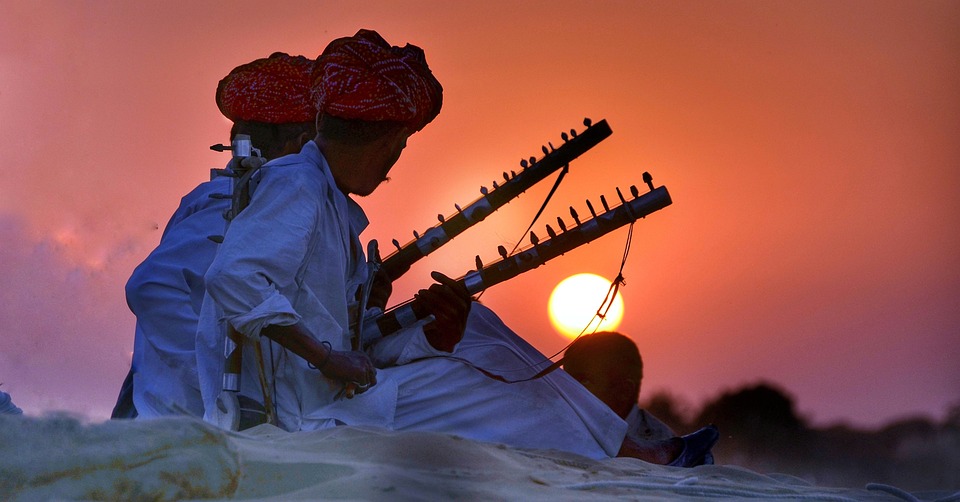India has always been known for its rich and diverse culture. One aspect of Indian culture that has caught the attention of people worldwide is its music. The country is home to an eclectic mix of different styles of music, each with its own history and tradition. From classical music to Bollywood, India’s music scene is truly vibrant and unique.
The origins of Indian classical music can be traced back to the Vedic period, with references to music found in ancient texts such as the Vedas and Upanishads. The music genre is known for its intricate melodies and rhythms, with each piece often taking hours to perform. The classical music scene in India has seen a resurgence in recent times, with young musicians experimenting with traditional forms and incorporating modern elements.
Bollywood music, on the other hand, is a genre that has gained immense popularity both within and outside of India. The music is used as a major component in Hindi films, and its upbeat and catchy tunes have made it a favorite among listeners globally. The popularity of Bollywood music has given rise to a whole new generation of singers and composers, who are constantly pushing the boundaries of what is possible.
In addition to classical and Bollywood music, India is also home to a thriving independent music scene. Independent artists from various parts of the country have broken through the mainstream and are creating music that is unique and diverse. These artists are using music as a means of expressing themselves and their experiences, and the result is a rich and colorful tapestry of sounds.
Another fascinating aspect of India’s music scene is the fusion of different styles and genres. Musicians are constantly experimenting with different sounds and blending them seamlessly to create something new and exciting. This approach has given rise to a new wave of music that is an amalgamation of various styles and cultures.
Despite the challenges that musicians face in India, such as lack of infrastructure and funding, the music scene is thriving. Young musicians are finding new platforms to showcase their talent, and the internet has made it easier for them to reach a wider audience. As a result, the music industry in India is growing rapidly, and there is a renewed sense of excitement and energy among musicians and music lovers alike.
In conclusion, exploring India’s vibrant music scene is like embarking on a journey to discover a whole new world of sounds and rhythms. From the classical music of the past to the cutting-edge music of the future, India’s music scene has something for everyone. So, whether you are a die-hard fan of Bollywood music or an avid listener of independent music, India has a lot to offer. So, sit back, relax, and let the music take you on a journey you will never forget.
The Diversity of Indian Music
India is known for its vast multicultural landscape, and its music scene is no exception. Each state, city and even neighbourhood has its own unique style of music. From the classical tones of Hindustani and Carnatic music to the blend of Indian and Western influences in Bollywood tunes, there’s a sound to suit every ear. Even within genres, the use of different instruments and vocal techniques can create interesting variations.
Traditionally, Indian music is linked to cultural, social and spiritual events, and many styles and forms have evolved over the centuries. Folk music, for instance, draws from local tales and mythologies, while devotional music reflects the religious beliefs of the people. Indian classical music, on the other hand, is a highly structured form that requires years of training and practice to master.
The Role of Music in Indian Society
Music in India is deeply intertwined with culture and tradition, and it plays a significant role in everyday life. From lullabies that soothe babies to devotional music that connects people to their faith, music is an integral part of Indian society. Many traditional events, such as weddings and festivals, are incomplete without music and dance performances.
Over the years, the music scene in India has also diversified to cater to different tastes and preferences. Today, most Indians consume music through various mediums, such as radio, TV, streaming apps and live performances. In big cities like Mumbai, Bangalore and Delhi, music clubs and bars have also emerged as important platforms for budding artists to showcase their talents.
The Evolution of Bollywood Music
Bollywood music, also known as film music, is an integral part of Indian pop culture. The industry produces hundreds of films every year, and each comes with its own set of songs and dances. In the early days of Hindi cinema, the music was more influenced by classical and folk styles, but over time, it has evolved to reflect the tastes of younger audiences.
Bollywood music today is a blend of different genres, including rock, hip hop and electronic dance music. The use of catchy beats, peppy lyrics and upbeat tunes makes it a hit among the masses. However, some critics argue that the industry’s focus on creating chart-topping hits has led to a decline in the quality of music and lyrics.
The Rise of Indie Music
The indie music scene in India has gained momentum in recent years, with dozens of small bands and independent artists coming up. A departure from mainstream Bollywood music, indie music is more experimental and often draws from Western influences. Many independent artists often perform in small venues and clubs, and some have even gained a global following.
The rise of technology and social media has also helped indie artists gain more visibility. With the proliferation of streaming services and online music platforms, it has become easier for independent musicians to distribute their music and connect with fans without the need for big record labels.
The Impact of Western Music on Indian Music Scene
The influence of Western music on Indian music can be traced back to the colonial era, when British soldiers and officials introduced their music to the locals. Since then, Indian music has seen a gradual integration of Western influences, especially in the genres of rock, jazz, and blues. Western instruments such as the guitar, drums, and piano have also made their way into Indian music.
The fusion of Indian and Western music has led to the emergence of new genres such as Indian rock, which fuses rock elements with Indian classical music. However, some critics argue that the adoption of Western music has eroded the authenticity of traditional Indian music, and have called for a return to roots.
The Future of Indian Music
The Indian music scene is constantly evolving, and the future looks promising. With the rise of indie music and the increasing popularity of traditional genres, there’s scope for more experimentation and innovation. The use of technology and social media is also expected to play a significant role in the growth of the industry, as artists can now connect directly with their fans and monetize their music.
However, challenges such as the need for better infrastructure and support for independent artists, and the quest for preserving traditional music amidst a changing landscape, need to be addressed. With the right policies and initiatives in place, India’s vibrant music scene can continue to thrive and inspire.
Conclusion
India’s music scene is as diverse and vibrant as the country itself, with each state and city having its own unique sound. From traditional classical music to Bollywood hits and indie music, there’s something for everyone. The impact of Western music has also been felt, with fusion genres emerging. However, as the industry evolves, it is crucial to preserve traditional music while embracing new sounds and styles. With the right policies and initiatives in place, India’s music scene is poised for growth in the coming years.
Summary
India’s music scene is diverse, colorful, and full of history. From classical music to Bollywood, the country has a range of music genres that have gained popularity worldwide. Indian classical music dates back to the Vedic period and is known for its intricate melodies and rhythms. Bollywood music has gained immense popularity, and its catchy tunes have made it a favorite among listeners globally. India’s independent music scene is also thriving, with artists creating unique and diverse sounds that express their experiences. The fusion of different styles and genres is another fascinating aspect of India’s music scene. Despite challenges, India’s music industry is growing rapidly, and there is a renewed sense of excitement and energy among musicians and music lovers alike.

FAQ
What is the traditional music of India?
Indian classical music is the traditional music of India. It is a complex system of melody, rhythm and improvisation that has been refined and developed over centuries. There are two main branches of classical music in India – Hindustani classical music which is practiced in the northern regions and Carnatic classical music which is practiced in the southern regions. Both forms have their own unique styles and instruments, but share a similar approach to melody and improvisation.
Indian classical music is still very much alive today and is performed in concerts and festivals across the country. Many contemporary musicians also draw inspiration from classical music, blending it with other genres to create new and exciting sounds.
What are some popular genres of music in India?
Alongside classical music, there are many popular genres of music in India. Bollywood music is a particularly popular genre and is often characterized by catchy melodies and upbeat rhythms. Indian rock music has also gained popularity in recent years, with bands like Indian Ocean and Parikrama leading the way. There are also many regional genres of music in India, such as Bhangra from Punjab and Bihu from Assam.
In addition, there are many contemporary artists in India who are experimenting with fusion music, mixing traditional Indian sounds with elements of Western music or electronic music to create new and exciting sounds.
What are some famous music festivals in India?
India has a vibrant festival culture, and music festivals are no exception. One of the most famous music festivals in India is the Sawai Gandharva Music Festival, which takes place annually in Pune and showcases some of the best classical musicians from across the country. Other popular festivals include the NH7 Weekender, which features a mix of indie, rock and electronic music, and the Sunburn Festival, which is India’s largest electronic dance music festival.
There are also many regional music festivals in India that celebrate local music, such as the Hornbill Festival in Nagaland which showcases the traditional music and dance of the Naga tribes.
How has the music scene in India evolved over the years?
The music scene in India has evolved significantly over the years. In the past, classical music was the predominant form of music, with folk and devotional music also being popular. However, with the advent of Bollywood in the 1940s, film music became an important part of Indian music culture.
In recent years, there has been a surge in independent music in India. The rise of social media and streaming platforms has made it easier for independent artists to reach a wider audience, and many new genres of music are now emerging. Indian musicians are also collaborating with artists from around the world, creating a truly global music scene. Overall, the music scene in India is more diverse and vibrant than ever before, with something to offer for every taste




